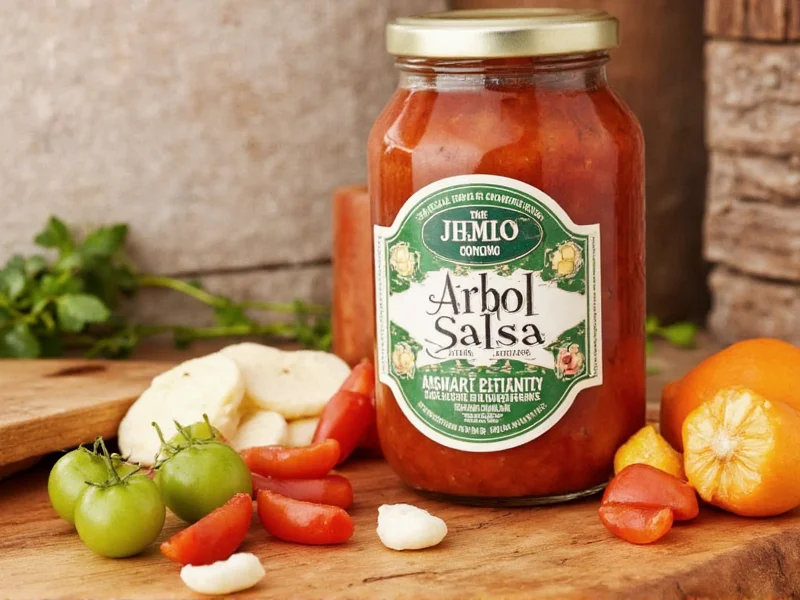Understanding what is arbol salsa requires exploring its roots in Mexican culinary tradition. The name "árbol" means "tree" in Spanish, referring to how these slender chiles are often hung to dry on trees or rafters. Unlike many commercial salsas that prioritize sweetness or extreme heat, authentic arbol salsa maintains a perfect equilibrium between spice, acidity, and subtle smokiness.
Origin and Cultural Significance
Árbol chiles have been cultivated in Mexico for centuries, with evidence of their use dating back to pre-Hispanic times. These chiles became particularly prominent in central and northern Mexican cuisine, where they're valued for their ability to add depth without dominating a dish. Traditional arbol salsa preparation methods have been passed down through generations, often varying by region and family.
Key Ingredients and Preparation
The essential components of authentic arbol salsa include:
- Dried árbol chiles (typically 5-10 for a standard batch)
- Garlic (2-4 cloves)
- White vinegar or lime juice
- Water or broth
- Salt to taste
- Optional: tomatoes, onions, or cumin for variation
Preparation involves toasting the dried chiles briefly in a dry skillet to enhance their flavor, then soaking them in hot water until softened. The rehydrated chiles are blended with other ingredients until smooth. Some traditional preparations use a molcajete (Mexican mortar and pestle) for a more textured consistency.
| Salsa Type | Heat Level (Scoville) | Primary Ingredients | Flavor Profile |
|---|---|---|---|
| Arbol Salsa | 25,000-30,000 | Dried árbol chiles, garlic, vinegar | Smoky, bright, medium-high heat |
| Chipotle Salsa | 2,500-8,000 | Smoked jalapeños, tomatoes, spices | Deeply smoky, sweet, mild-medium heat |
| Pico de Gallo | 500-1,000 | Fresh tomatoes, onions, cilantro, jalapeños | Fresh, bright, mild heat |
| Habanero Salsa | 100,000-350,000 | Habanero chiles, fruit, vinegar | Intense heat with tropical fruit notes |
Flavor Profile and Heat Level Explained
When exploring what is arbol salsa, understanding its distinctive flavor profile is essential. Árbol chiles deliver a clean, sharp heat that builds gradually rather than overwhelming the palate immediately. The heat registers between 25,000-30,000 Scoville heat units—significantly hotter than jalapeños (2,500-8,000 SHU) but milder than habaneros (100,000-350,000 SHU).
The flavor complexity comes from the natural nuttiness of the dried chiles, enhanced by the toasting process. Unlike some salsas that rely on added sugar to balance heat, traditional arbol salsa achieves balance through the interplay of vinegar's acidity and the chile's natural fruitiness. This makes it particularly versatile for what is arbol salsa used for in authentic Mexican cooking.
Traditional Uses in Mexican Cuisine
Authentic arbol salsa serves as more than just a condiment—it's an integral component in many traditional dishes. Common applications include:
- As a table sauce for tacos, especially carne asada and al pastor
- Marinade base for grilled meats and vegetables
- Ingredient in enchilada sauces and mole variations
- Flavor enhancer for bean dishes and soups
- Breakfast companion for huevos rancheros and chilaquiles
Chefs appreciate arbol salsa for its ability to add depth without masking other flavors—a quality that distinguishes it from what is arbol salsa vs chipotle salsa, which tends to be smokier and sweeter.
Homemade vs Commercial Arbol Salsa
While store-bought arbol salsa offers convenience, homemade versions typically provide superior flavor complexity. Commercial products often contain preservatives, sugar, or thickeners that alter the traditional profile. When making arbol salsa at home, the quality of dried chiles significantly impacts the final product—look for deep red, pliable chiles without excessive brittleness.
For those wondering what is arbol salsa made of in authentic preparations, the ingredient list remains deliberately simple. Traditional recipes avoid tomatoes, which some commercial brands add to stretch the product. The pure chile-garlic-vinegar combination creates a more intense, focused flavor that represents the true essence of this Mexican staple.
Storage and Shelf Life
Properly stored, homemade arbol salsa maintains quality for 2-3 weeks in the refrigerator. For extended shelf life, consider these storage methods:
- Refrigeration: Store in an airtight container for up to 3 weeks
- Freezing: Portion into ice cube trays, then transfer to freezer bags for up to 6 months
- Canning: Properly processed in sterilized jars for pantry storage up to 1 year
The vinegar content naturally preserves the salsa, but always check for signs of spoilage before use. Commercial arbol salsa typically contains preservatives that extend shelf life to 6-12 months unopened, with a shorter window after opening.
Regional Variations Across Mexico
What is arbol salsa like in different Mexican regions reveals interesting culinary adaptations. In central Mexico, recipes often include roasted garlic and a touch of cumin. Northern versions sometimes incorporate beef broth for added richness, while coastal preparations might feature a hint of citrus. These regional differences showcase Mexico's diverse culinary landscape while maintaining the essential characteristics that define authentic arbol salsa.











 浙公网安备
33010002000092号
浙公网安备
33010002000092号 浙B2-20120091-4
浙B2-20120091-4